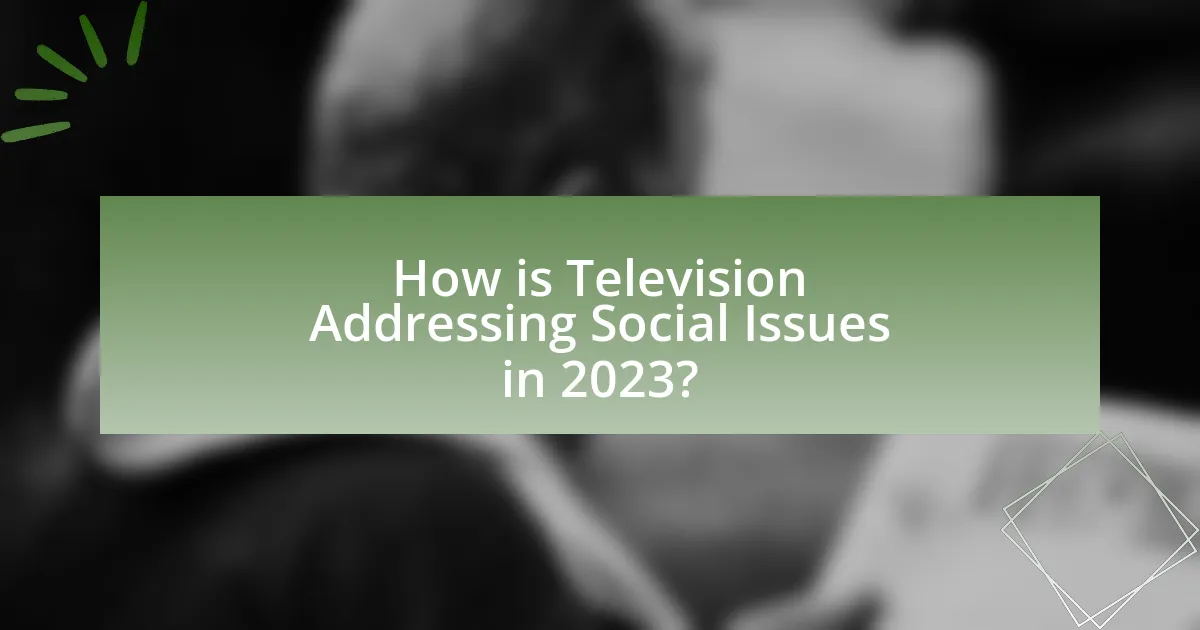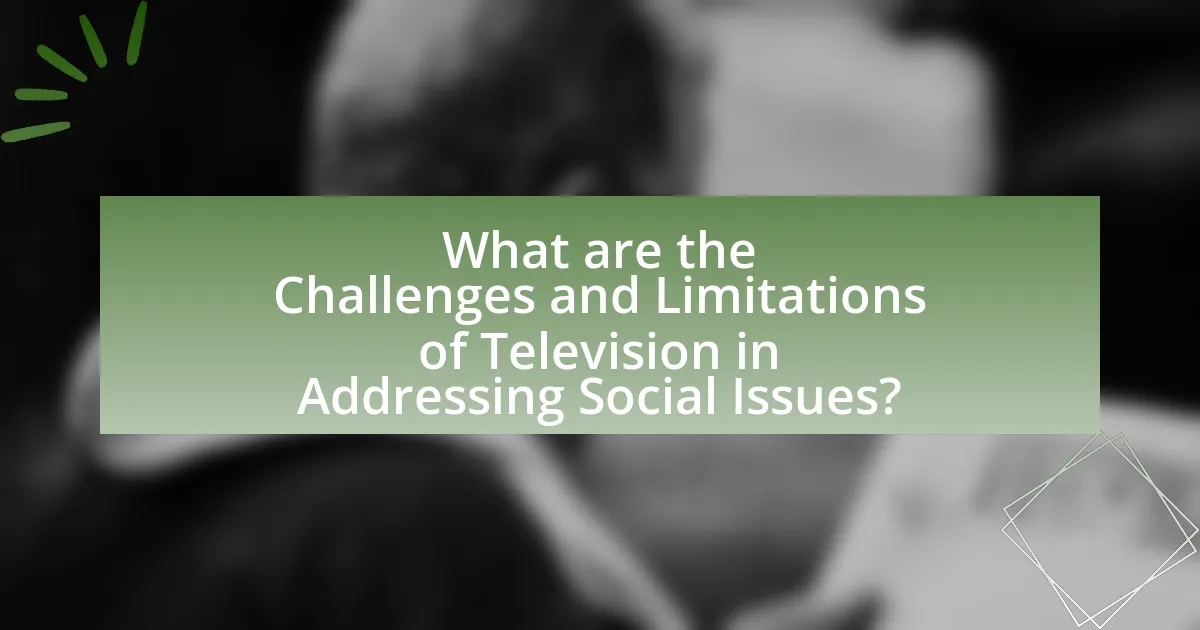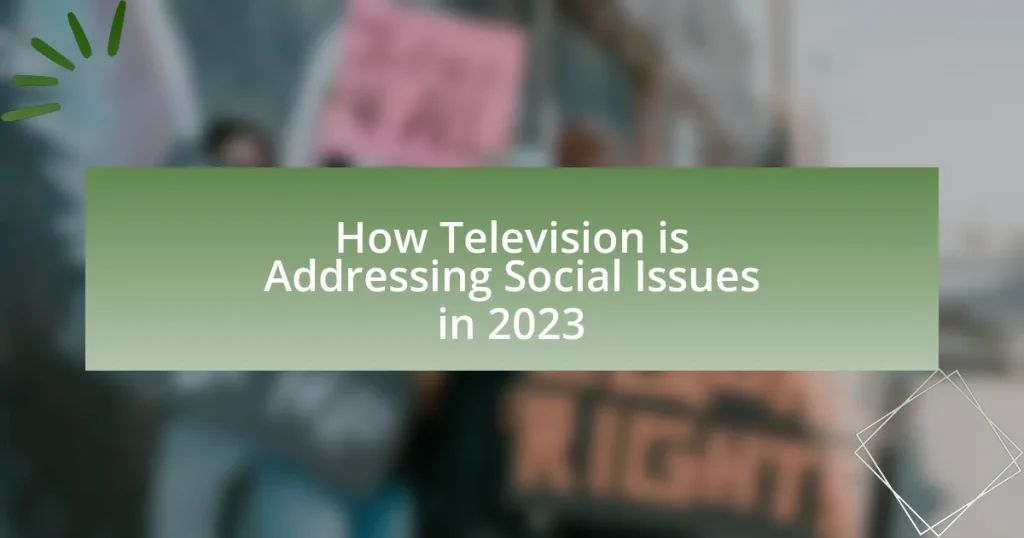Television in 2023 is increasingly addressing social issues through diverse storytelling and representation, focusing on topics such as mental health, racial inequality, climate change, and gender identity. Key shows like “This Is Us” and “The Good Fight” exemplify this trend by fostering dialogue around grief and systemic racism. The article explores how television serves as a powerful medium for social change, highlighting the importance of authentic portrayals, audience engagement strategies, and the impact of viewer feedback on programming decisions. Additionally, it discusses the challenges creators face in tackling these issues and the best practices for responsible storytelling.

How is Television Addressing Social Issues in 2023?
Television in 2023 is addressing social issues through diverse storytelling, representation, and the incorporation of real-world events into narratives. Many shows are focusing on topics such as mental health, racial inequality, and climate change, reflecting societal concerns and fostering dialogue. For instance, series like “This Is Us” and “The Good Fight” have tackled issues like grief and systemic racism, respectively, resonating with audiences and prompting discussions. Additionally, networks are increasingly prioritizing inclusive casting and authentic portrayals, which enhance relatability and awareness of various social issues. This approach not only entertains but also educates viewers, making television a powerful medium for social change.
What are the key social issues being addressed by television this year?
Television in 2023 is addressing key social issues such as mental health awareness, racial inequality, climate change, and gender identity. Programs are increasingly focusing on mental health, with series depicting the struggles and stigma surrounding mental illness, reflecting a growing societal recognition of its importance. Racial inequality is prominently featured, with shows highlighting systemic racism and promoting diverse narratives, which aligns with ongoing social movements advocating for racial justice. Climate change is another critical issue, as documentaries and dramas raise awareness about environmental challenges and inspire action. Additionally, gender identity is being explored through characters and storylines that challenge traditional norms, fostering greater understanding and acceptance. These themes resonate with audiences and contribute to broader societal conversations.
How are issues like mental health portrayed in 2023 television shows?
In 2023, television shows portray mental health issues with increased authenticity and complexity, reflecting real-life struggles and promoting awareness. Series such as “Euphoria” and “This Is Us” delve into the nuances of mental health, showcasing characters grappling with anxiety, depression, and trauma in relatable ways. These portrayals often include expert consultations and collaborations with mental health organizations to ensure accuracy, as seen in the partnership between “Euphoria” and the National Alliance on Mental Illness. This approach not only fosters empathy among viewers but also encourages open discussions about mental health, reducing stigma and promoting understanding.
What role does television play in raising awareness about climate change?
Television plays a crucial role in raising awareness about climate change by disseminating information to a broad audience through documentaries, news segments, and educational programs. For instance, programs like “Our Planet” and “Years of Living Dangerously” have highlighted the impacts of climate change, reaching millions of viewers and prompting discussions on environmental issues. Research indicates that visual storytelling can significantly influence public perception and understanding of complex topics, making television an effective medium for conveying the urgency of climate action.
Why is television an effective medium for discussing social issues?
Television is an effective medium for discussing social issues because it reaches a wide audience and engages viewers emotionally. The visual and auditory elements of television create a compelling narrative that can illustrate complex social issues in relatable ways. For instance, programs like “13 Reasons Why” have sparked conversations about mental health and suicide, demonstrating how storytelling can raise awareness and foster dialogue. Additionally, according to a 2021 Nielsen report, 88% of U.S. households watch television, highlighting its extensive reach and influence in shaping public perception on social matters.
How does the visual storytelling of television enhance understanding of social issues?
Visual storytelling in television enhances understanding of social issues by providing relatable narratives that evoke empathy and foster awareness. Through character-driven plots and realistic scenarios, viewers can engage emotionally with complex topics such as poverty, racism, and mental health. For instance, series like “This Is Us” and “The Handmaid’s Tale” illustrate personal struggles within broader societal contexts, making abstract issues more tangible. Research indicates that visual media can significantly influence public perception and attitudes; a study by the American Psychological Association found that exposure to empathetic storytelling can lead to increased social awareness and advocacy. Thus, television serves as a powerful medium for educating audiences about social issues through its compelling visual narratives.
What audience engagement strategies are used in television to address social issues?
Television employs various audience engagement strategies to address social issues, including interactive storytelling, social media integration, and community outreach initiatives. Interactive storytelling allows viewers to participate in narratives that reflect social issues, fostering a deeper connection and understanding. Social media integration enables real-time discussions and feedback, amplifying the reach and impact of the content. Community outreach initiatives, such as partnerships with local organizations, create opportunities for viewers to engage in activism and support related causes. These strategies have been shown to enhance viewer awareness and involvement, as evidenced by programs that have successfully mobilized audiences around issues like mental health and racial equality.
What trends are emerging in television’s approach to social issues in 2023?
In 2023, television is increasingly focusing on authentic representation and intersectionality in its approach to social issues. This trend is evident as networks and streaming platforms prioritize diverse storytelling that reflects the complexities of various identities and experiences. For instance, shows like “The Bear” and “This Is Us” have garnered attention for their nuanced portrayals of mental health and family dynamics, highlighting the importance of addressing these topics with sensitivity and depth. Additionally, the rise of docuseries, such as “The Last Dance,” showcases real-life social issues, further emphasizing the medium’s role in fostering dialogue and awareness. This shift towards inclusivity and realism in storytelling is supported by audience demand for content that resonates with their lived experiences, as evidenced by increased viewership and engagement metrics across platforms.
How are streaming platforms influencing the portrayal of social issues?
Streaming platforms are significantly influencing the portrayal of social issues by providing diverse narratives that reflect contemporary societal challenges. These platforms, such as Netflix and Hulu, prioritize original content that addresses topics like mental health, racial inequality, and LGBTQ+ rights, often leading to increased visibility and awareness. For instance, shows like “13 Reasons Why” have sparked discussions about mental health and suicide, while “When They See Us” highlights racial injustice in the criminal justice system. This trend is supported by data indicating that 67% of viewers believe streaming content has improved their understanding of social issues, demonstrating the platforms’ role in shaping public discourse and fostering empathy.
What role do diverse voices play in shaping narratives around social issues?
Diverse voices play a crucial role in shaping narratives around social issues by providing varied perspectives that enrich the discourse and foster understanding. These voices contribute to a more comprehensive representation of experiences, particularly for marginalized communities, which can lead to more nuanced storytelling in television programming. For instance, research by the Geena Davis Institute on Gender in Media found that films and television shows with diverse casts are more likely to address social issues authentically, reflecting the realities of a multicultural society. This inclusion not only enhances the relatability of the narratives but also encourages empathy among audiences, ultimately influencing public perception and dialogue surrounding critical social topics.

How are Viewers Responding to Social Issues in Television?
Viewers are increasingly engaging with social issues presented in television by actively discussing, sharing, and advocating for change based on the narratives they encounter. This engagement is evidenced by the rise in social media conversations surrounding shows that tackle topics such as racial inequality, mental health, and climate change. For instance, a study by the Pew Research Center in 2022 found that 63% of viewers reported feeling more informed about social issues after watching relevant television programs. Additionally, shows like “This Is Us” and “The Handmaid’s Tale” have sparked significant viewer discourse, leading to increased awareness and activism, as viewers often take to platforms like Twitter and Instagram to express their thoughts and mobilize support for related causes.
What impact do television portrayals of social issues have on viewer perceptions?
Television portrayals of social issues significantly shape viewer perceptions by influencing attitudes, beliefs, and understanding of those issues. Research indicates that when social issues are depicted on television, they can lead to increased awareness and empathy among viewers, as evidenced by studies showing that exposure to narratives about mental health or racial inequality can reduce stigma and foster supportive attitudes. For instance, a study published in the Journal of Communication found that viewers who watched programs addressing LGBTQ+ issues reported more positive attitudes towards the community, highlighting the role of media in shaping social norms and perceptions.
How do audiences engage with content that addresses social issues?
Audiences engage with content that addresses social issues primarily through active participation, emotional resonance, and social sharing. Research indicates that viewers often connect with narratives that reflect their own experiences or highlight injustices, leading to increased empathy and awareness. For instance, a study by the Pew Research Center found that 63% of Americans believe that media coverage of social issues influences public opinion and can motivate individuals to take action, such as participating in protests or advocacy campaigns. This engagement is further amplified by social media platforms, where audiences share their thoughts and experiences related to the content, fostering community discussions and collective action.
What feedback mechanisms exist for viewers to express their opinions on social issue portrayals?
Viewers can express their opinions on social issue portrayals through various feedback mechanisms, including social media platforms, online forums, and viewer surveys. Social media platforms like Twitter and Facebook allow users to comment, share, and engage in discussions about specific shows and their content, providing immediate feedback to producers and networks. Online forums, such as Reddit, enable viewers to participate in deeper conversations and critiques regarding social issues depicted in television. Additionally, networks often conduct viewer surveys to gather structured feedback on audience perceptions and reactions to social issue portrayals, allowing for quantitative analysis of viewer sentiments. These mechanisms collectively facilitate a dialogue between audiences and content creators, influencing future programming decisions.
Why is audience feedback important for television networks?
Audience feedback is crucial for television networks because it directly influences programming decisions and content development. By analyzing viewer responses, networks can gauge audience preferences, identify trends, and adjust their offerings to better align with viewer expectations. For instance, a Nielsen report indicates that shows with high audience engagement often see increased ratings and advertising revenue, demonstrating the financial impact of audience feedback on network success. This feedback loop allows networks to create more relevant and socially conscious content, ultimately enhancing viewer satisfaction and loyalty.
How can viewer responses shape future programming related to social issues?
Viewer responses can significantly shape future programming related to social issues by providing direct feedback that influences content creation and network decisions. For instance, when audiences engage with shows addressing topics like racial inequality or mental health, their reactions—whether positive or negative—can lead networks to adjust storylines, increase representation, or prioritize certain issues in future programming. A notable example is the series “13 Reasons Why,” which sparked extensive viewer discussion and led to increased awareness and programming focused on mental health resources. This demonstrates that viewer engagement not only reflects societal interests but also drives networks to align their content with audience values and concerns, ultimately shaping the narrative landscape around social issues.
What are the consequences of ignoring audience feedback on social issues?
Ignoring audience feedback on social issues can lead to significant consequences, including a disconnect between content creators and viewers, resulting in decreased engagement and viewership. When television networks fail to acknowledge the perspectives and concerns of their audience, they risk alienating key demographics, which can diminish their relevance and impact. For instance, a study by the Pew Research Center found that 63% of viewers prefer content that reflects their values and experiences, indicating that neglecting audience input can lead to a loss of trust and loyalty. Additionally, ignoring feedback may perpetuate stereotypes or misinformation, further exacerbating social issues rather than contributing to constructive dialogue. This can ultimately harm the credibility of the network and its programming, as audiences increasingly seek authentic representation and responsiveness in media.

What are the Challenges and Limitations of Television in Addressing Social Issues?
Television faces significant challenges and limitations in addressing social issues, primarily due to its reliance on commercial interests and the constraints of time and format. Commercial networks prioritize advertising revenue, which can lead to superficial coverage of complex social issues, as seen in the limited airtime dedicated to topics like poverty or systemic racism. Additionally, the format of television often necessitates simplification of narratives, resulting in a lack of depth and nuance in discussions. For instance, a study by the Pew Research Center in 2021 indicated that only 20% of news segments on major networks provided in-depth analysis of social issues, limiting viewers’ understanding and engagement. Furthermore, the audience’s preferences for entertainment over informative content can skew programming choices, further marginalizing critical social topics.
What challenges do creators face when tackling social issues in television?
Creators face significant challenges when tackling social issues in television, primarily due to audience backlash and network constraints. Audience backlash can arise from differing opinions on sensitive topics, leading to potential boycotts or negative reviews, which can impact viewership and advertising revenue. Additionally, networks often impose restrictions based on perceived marketability, limiting creative freedom and the depth of exploration into complex social issues. For instance, a study by the Pew Research Center in 2021 indicated that 60% of viewers prefer content that aligns with their beliefs, which can pressure creators to avoid controversial subjects. These factors create a challenging environment for creators aiming to address important social issues authentically and effectively.
How do network policies and censorship affect the portrayal of social issues?
Network policies and censorship significantly shape the portrayal of social issues by controlling the content that can be broadcasted. These regulations often lead to the suppression of critical narratives, limiting the diversity of perspectives presented on television. For instance, in countries with strict censorship laws, topics such as political dissent, LGBTQ+ rights, and racial inequality may be underrepresented or misrepresented, as seen in the 2021 report by Freedom House, which indicated that media freedom is declining globally. This suppression can result in a skewed public perception of social issues, as audiences are not exposed to the full spectrum of discussions and realities surrounding these topics.
What are the risks of oversimplifying complex social issues in television narratives?
Oversimplifying complex social issues in television narratives risks perpetuating stereotypes and misinformation. This reductionist approach can lead to a lack of understanding among viewers, as nuanced realities are often ignored. For instance, a study by the American Psychological Association found that media portrayals significantly influence public perception, suggesting that oversimplified narratives can reinforce harmful biases and limit critical discourse. Additionally, oversimplification can alienate marginalized communities whose experiences are not accurately represented, further entrenching social divides.
How can television improve its approach to social issues?
Television can improve its approach to social issues by prioritizing authentic representation and inclusive storytelling. By featuring diverse voices and perspectives, television can better reflect the complexities of social issues, fostering empathy and understanding among viewers. Research indicates that shows with diverse casts and storylines, such as “Orange Is the New Black,” have positively impacted public perceptions of marginalized communities, demonstrating the effectiveness of representation in driving social change. Additionally, incorporating expert opinions and real-life narratives can enhance the credibility and depth of discussions surrounding social issues, making them more relatable and actionable for audiences.
What best practices can be adopted for more responsible storytelling?
Responsible storytelling can be enhanced by prioritizing authenticity, inclusivity, and accuracy. Authenticity involves representing characters and narratives that reflect real-life experiences, ensuring that diverse voices are heard and portrayed accurately. Inclusivity requires the inclusion of various perspectives, particularly those from marginalized communities, to foster a broader understanding of social issues. Accuracy is crucial in presenting facts and avoiding stereotypes, which can misinform audiences. For instance, research by the Annenberg Inclusion Initiative highlights that diverse representation in media leads to more nuanced storytelling and better audience engagement. By adopting these best practices, storytellers can contribute to a more informed and empathetic society.
How can collaboration with experts enhance the accuracy of social issue portrayals?
Collaboration with experts enhances the accuracy of social issue portrayals by integrating specialized knowledge and insights into the narrative. Experts provide data-driven perspectives, ensuring that the representation of social issues is grounded in reality rather than stereotypes or misconceptions. For instance, when television shows consult sociologists or psychologists, they can depict mental health issues with greater sensitivity and accuracy, reflecting current research findings on the subject. This collaboration can lead to more informed storytelling, as evidenced by series that have successfully tackled complex topics like addiction or systemic racism, often resulting in increased viewer awareness and understanding.
What can viewers do to support responsible television programming on social issues?
Viewers can support responsible television programming on social issues by actively engaging with content, providing feedback, and advocating for diverse representation. Engaging with content includes watching programs that address social issues and discussing them on social media platforms, which can amplify the reach and impact of these narratives. Providing feedback to networks through surveys or direct communication encourages producers to prioritize responsible storytelling. Advocating for diverse representation involves supporting initiatives and organizations that promote inclusivity in media, thereby influencing networks to create more balanced and accurate portrayals of various social issues.




